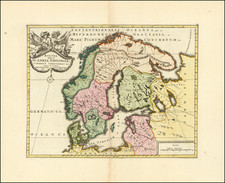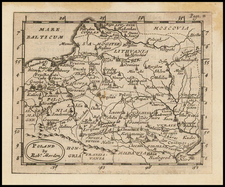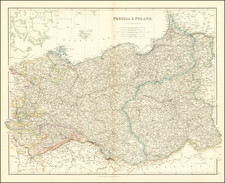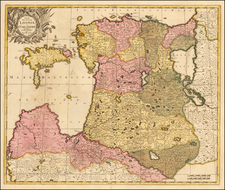Striking full color, gold heighten example of Goos' general chart of Baltic Sea, extending to the coasts of Finland, Scandinavia, Latvia, Lithuania, Estonia, Poland, Denmark, etc..
Pieter Goos (1616-1675) was a Dutch map and chart maker, whose father Abraham Goos (approx. 1590-1643) had already published numerous globes, land and sea maps together with Jodocus Hondius and Johannes Janssonius in Antwerp. Pieter Goos cameto prominence in the publication of Sea Charts after he bought the copperplates of the famous guide book for sailors 'De Lichtende Columne ofte Zeespiegel' (Amsterdam 1644, 1649, 1650) from Anthonie Jacobsz. Goos published his own editions of this work in various languages, while adding his own maps. In 1666, he published his 'De Zee-Atlas ofte Water-Weereld', which is considered one of the best sea atlases of its time. Goos' sea charts came to dominate the Dutch market for Sea Charts until the 1680s, when the Van Keulen family began to come to prominence.
Pieter Goos (ca. 1616-1675) was a Dutch map and chart maker, whose father, Abraham Goos (approx. 1590-1643), had already published numerous globes, land and sea maps together with Jodocus Hondius and Johannes Janssonius in Antwerp. Pieter gained recognition due to the publication of sea charts. He bought the copperplates of the famous guide book for sailors, De Lichtende Columne ofte Zeespiegel (Amsterdam 1644, 1649, 1650), from Anthonie Jacobsz. Goos published his own editions of this work in various languages, while adding his own maps. In 1666, he published his De Zee-Atlas ofte Water-Wereld, which is considered one of the best sea atlases of its time. Goos' sea charts came to dominate the Dutch market until the 1670s, when the Van Keulen family came to prominence.

![[Heightened in Gold!] Pas-Caart van de Oost Zee Verthoonende Alle de ghelgentheydt tusschen 't Eylandt Rugen ende Wyborg. Op nieuws oversien en verbeetert. . . 1665 By Pieter Goos](https://storage.googleapis.com/raremaps/img/small/83731.jpg)













